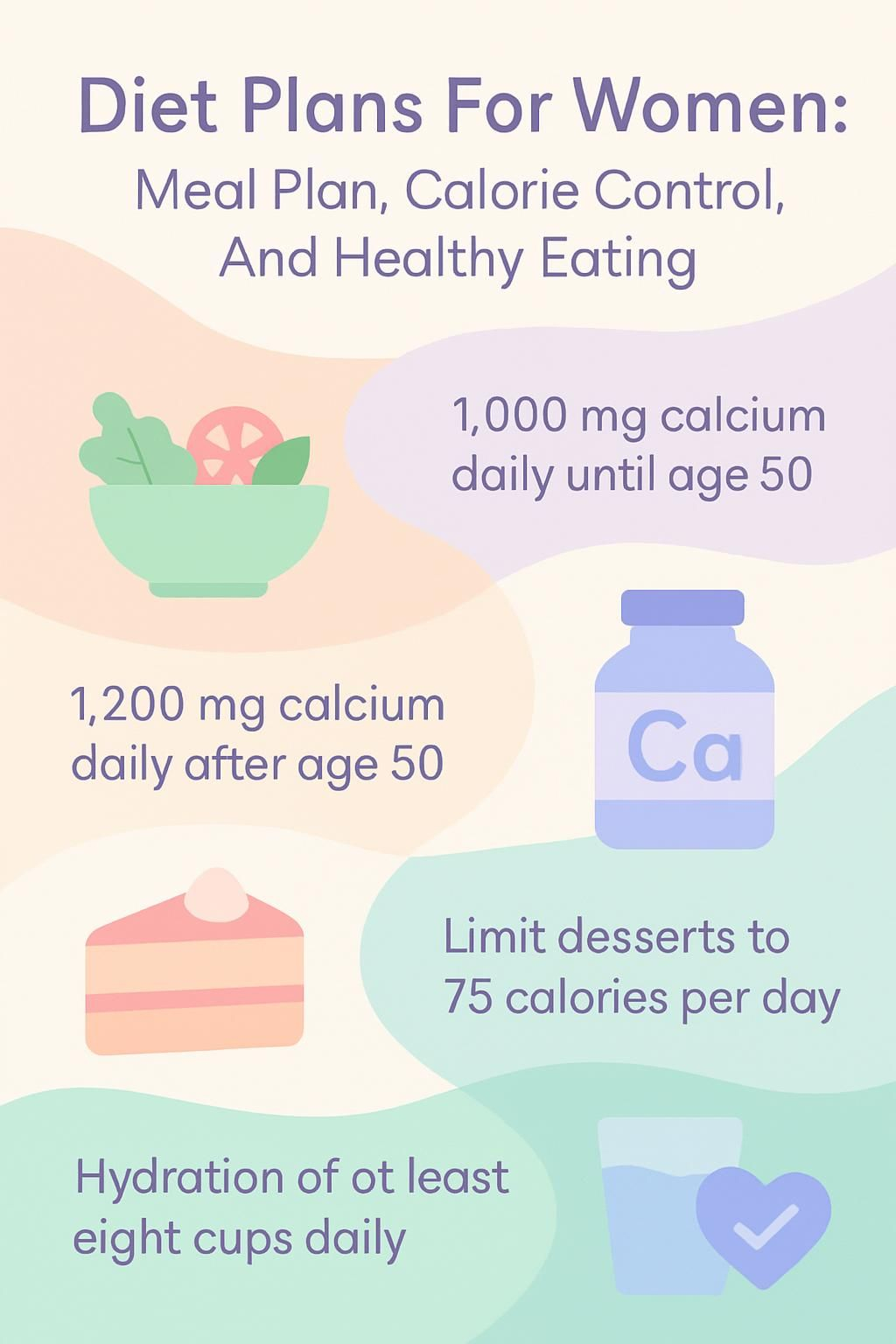Diet Plans For Women: Meal Plan, Calorie Control, And Healthy Eating
Our Nutrition Assistant AI Suite will transform your body. You will lose fat, get toned, and build muscle. Gain confidence and optimal health.
You want a simple way to eat well, feel better, and reach a healthy weight. A clear meal plan makes healthy eating less confusing and helps you manage your calorie needs. This guide shows you how to build an eating plan that fits your life and supports long-term health.
Research suggests that a balanced diet helps women manage weight, boost energy, and lower disease risk. You will learn how to plan meals, set smart portion sizes, and choose foods that support your goals. If you want practical steps, you are in the right place.
Key Takeaways
- Most women need about 1,000 mg of calcium daily until age 50, then 1,200 mg after 50 to support bone health, per the Dietary Guidelines for Americans.
- Balanced eating patterns, such as the Mediterranean Diet and DASH, emphasize vegetables, fruit, whole grain foods, and healthy fats. These patterns help lower the risk for heart disease and high blood pressure.
- Portion strategies work. Keep desserts to about 75 calories per day, use single-serve containers, and measure servings to control total calories.
- Make room for protein, iron sources like lean meat or beans, fiber-rich plants, and healthy fats such as olive oil or nuts. Aim for at least eight cups of fluid daily.
- Food journals and tracking apps support long-term weight management. Structured programs, like the Mayo Clinic Diet, use tracking to build daily habits.

Why Are Diet Plans Important for Women?

A good plan gives structure, which helps you meet nutrient needs and manage calories. It also reduces guesswork, so day-to-day choices feel easier.
What unique nutritional needs do women have?
Women often need more iron during the reproductive years because of monthly blood loss. Add iron-rich foods like lean beef, beans, lentils, and leafy greens. Pair plant iron with vitamin C, such as citrus, to improve absorption.
Calcium and vitamin D support bone strength and help reduce osteoporosis, a condition where bones become weak and fragile. The Dietary Guidelines for Americans suggest 1,000 mg of calcium a day from ages 19 to 50. After 50, aim for 1,200 mg per day.
Protein supports muscle, immune function, and recovery. Choose poultry, fish, eggs, nonfat yogurt, cottage cheese, beans, and seeds. Folate, a B vitamin, is crucial before and during pregnancy because it helps prevent birth defects.
Healthy fats from olive oil, nuts, and seeds support heart health. Limit saturated fat and avoid trans fat to reduce cardiovascular disease risk. Most adults do well with at least eight cups of fluid daily, more with activity or heat.
How can diet support hormonal balance?
Stable blood sugar supports steady hormones. Choose whole grains, beans, fish with omega-3s, nuts, and olive oil. These foods provide fiber and nutrients without sharp spikes in blood sugar.
Swap processed snacks for simple options like raw veggies, a small handful of nuts, or yogurt. Keep desserts small, about 75 calories, to ease cravings without big ups and downs in mood or energy. Load plates with vegetables and fruit, which are filling and low in calories.
This steady pattern helps you meet your individual needs through all life stages while keeping hormone health in view.
How do diet plans promote long-term health and wellness?
Structured plans teach portion sizes, calorie awareness, and smart food choices. Over time, these skills reduce the risk of diabetes, high blood pressure, coronary artery disease, and high cholesterol.
Patterns like the Mediterranean Diet or plant-forward plans can help calm inflammation and improve heart health. Simple tools like a food journal or weight tracker highlight progress and habits that work for you.
Slow, steady loss works best. Aim to lose 1 to 2 pounds per week. This pace is kinder to your body and supports lasting results.
Key Components of a Healthy Diet Plan
Your body thrives on a mix of foods. Variety across food groups helps you reach nutrition targets and maintain energy throughout the day.
What are balanced macronutrients for women?
Build each meal with carbohydrates, protein, and healthy fat. Choose whole grain cereals and breads, reduced-fat dairy, lean meats or beans, and nuts or seeds. These foods deliver lasting energy and steady fullness.
A practical target is 20 to 30 grams of protein per meal to support muscle and curb hunger. Include 1 to 2 servings of whole grains at breakfast and lunch. Use about 2 servings of unsaturated oil, about 14 grams total per day, such as olive oil or nut butters.
Fiber from vegetables, fruit, beans, and whole grains supports digestion and safe weight loss. The Mayo Clinic Diet highlights a balance of grains, dairy, meat or plant proteins, unsaturated oils, vegetables, and fruit. Vegetarian and vegan choices can fit these targets with ease.
Balanced plates with whole grains, healthy fats from nuts or seeds, lean proteins like eggs or legumes, and fiber-rich vegetables provide steady energy.
Which vitamins and minerals are essential for women?
Focus on key nutrients that support daily health.
- Calcium: builds bones and supports muscles. Include reduced-fat milk, cheese, and about 100 g of yogurt.
- Iron: supports oxygen transport and energy. Add leafy greens, beans, nuts, or about 65 g cooked lean mince.
- Vitamin C: helps absorb plant iron. Choose citrus, berries, or stewed plums.
- Magnesium: supports nerves and muscles. A small handful of unsalted nuts, about 30 g, helps.
- Vitamin E: acts as an antioxidant. Nuts and 2 servings of unsaturated oil, about 14 g total, boost intake.
- Vitamin K and folate: support clotting and new cell growth. A large green salad, about 2 cups, covers both.
- B vitamins: support energy production. Whole grains like oats, brown rice, and whole wheat pasta are reliable sources.
A colorful plate increases vitamin variety and supports immune health. For example, a salad with leafy greens, cucumber, orange slices, and hummus adds fiber plus a mix of vitamins in one simple meal.
How much water should women drink daily?
Your fluid needs depend on activity, climate, and fiber intake. Many plans highlight hydration without setting a strict number. As a starting point, aim for at least eight cups of total fluids daily. Drink more if you sweat or eat higher fiber foods like oats or sweet potatoes.
Coffee with milk, tea, and soup count toward your total fluids. Sipping water across the day and tracking drinks makes it easier to meet your goal.
Meal Planning for Women
Planning is like putting rails on a trail, it keeps you moving in the right direction. Meal planning saves time, reduces stress, and keeps portions reasonable.
What are the benefits of meal planning?
Planning supports portion control, balanced calories, and better food choices. It helps you avoid last-minute snacks like chocolate or heavy sauces.
With a meal plan, you can track food groups and include nutritious foods like quinoa or couscous. You can also adjust for allergies or preferences while keeping meals tasty and simple.
Advance planning cuts grocery costs and food waste. It also encourages habits that support heart health, so you can pair regular activity with better eating patterns.
How can I create a sustainable meal plan?
Use these steps to build a plan you can keep.
- Pick a flexible plan, such as the Mayo Clinic Diet. Adjust calories to fit your needs. Try 1,300 to 1,500 calories if 1,200 is too low.
- Include all food groups. Aim for vegetables high in fiber, whole grains like rice or oats, lean proteins, and healthy fats such as nuts or olive oil to support brain health.
- Choose simple, affordable recipes. Baking or roasting cuts the need for cream or heavy sauces.
- Track meals, weight, and activity in a journal or app. Awareness helps with calorie control.
- Snack smart. Use fruit or raw vegetables for fullness between meals instead of processed foods.
- Limit sodium and added sugar. Choose fresh foods, skinless meats, and leafy salads with light dressing to support heart health.
- Plan meals around your week. Batch-cook staples like brown rice for quick assembly on busy days.
- Stay hydrated. About 9 cups of water per day fits the 2020-2025 Dietary Guidelines for Americans for many women.
- Adjust for your life stage or health conditions with a registered dietitian for personalized guidance.
- Make prep a habit. For example, Sunday grain bowls with roasted vegetables and chickpeas can cover several lunches.
What does a sample 3-day meal plan look like?
Here is a flexible outline that manages calories, balances macros, and offers plant-based options.
- Day 1 breakfast: berries, fresh or frozen, with yogurt or oats for fiber and antioxidants.
- Day 1 lunch: salad with feta, olives, and a light vinaigrette. This Mediterranean-style plate includes healthy fats.
- Day 1 dinner: chickpeas cooked with a spicy chili paste, zucchini, and peppers. This plant-based dish offers protein and flavor.
- Day 2 breakfast: whole grain toast with eggs. Season with chili flakes, herbs, and lime for brightness without added sugar.
- Day 2 lunch: whole grain bowl with herbs, pine nuts, and cherry tomatoes for vitamins A and C.
- Day 2 dinner: quick gluten- and dairy-free stir-fry using leftover brown rice and plenty of vegetables.
- Day 3 breakfast: egg and veggie scramble with spinach or mushrooms. Use egg whites if you prefer a lower cholesterol option.
- Day 3 lunch: extra-firm tofu sautéed with olive oil and taco spices for a high-protein vegetarian choice.
- Day 3 dinner: mixed vegetables with herbs and spices plus a slice of crusty whole grain bread for fiber.
- Use fresh or frozen ingredients as needed. Keep flavor high and costs sensible.
- These choices support healthy cholesterol levels and are linked to reduced risk of chronic disease in nutrition research.
This 3-day plan supports calorie control and plant-forward eating found in many evidence-based diets, including the Mediterranean Diet.
Calorie Control and Portion Management
Calorie control does not require perfection. Small steps, repeated daily, drive progress.
How do I calculate daily calorie needs?
Start with age, height, weight, and activity level. Many women ages 19 to 50 who are lightly active do well with about 1,200 calories for weight loss. If you are larger or more active, you may need closer to 1,600 to 1,800 calories.
The Healthy Weight Pyramid focuses on portions rather than strict calorie counts. Base meals around vegetables and fruit, then add whole grains, lean proteins, and healthy fats. This approach allows steady energy without constant number crunching.
Speak with a registered dietitian before starting any very-low-calorie diet. Safety and fit matter as much as speed.
What are effective portion control tips?
- Use single-serve containers for snacks like frozen desserts or nuts.
- Follow the Healthy Weight Pyramid. Eat more from the base, such as vegetables and fruit, and less from the top, such as sweets and processed foods.
- Measure portions. Four ounces of protein per meal is a useful guide. A kitchen scale or measuring cups improve accuracy.
- Keep desserts to about 75 calories daily, spread across the week, to manage sugar without feeling deprived.
- Know your serving sizes. For example, 60 g whole grain cereal at breakfast or 1 cup cooked pasta at dinner.
- Choose fruit as snacks instead of fried foods or fast-food sandwiches.
- Track portions in a journal or app to prevent mindless extra bites.
- Drink water before meals to ease hunger cues. Adjust total fluids based on activity.
- Cook and freeze meals in measured portions to avoid overeating later.
- Use measuring spoons for oils and dressings rather than free-pouring.
These habits make calorie control easier no matter your eating style, from Mediterranean patterns to careful low-calorie plans.
How can I avoid overeating and unhealthy snacking?
Set regular meal and snack times. This lowers the chance of grazing all day. Include protein at meals to stay full longer, about 20 to 30 grams per meal.
Keep fiber-rich snacks ready, such as sliced peppers, apples, or yogurt. Limit dessert portions to about 75 calories. Plan your snacks in the morning, then stick to your list to reduce impulse eating.
Track your food choices. Seeing patterns helps you fix triggers like late-night TV or stress. Create a short routine for evenings, such as herbal tea or a short walk, to replace mindless munching.
Popular Diet Plans for Women
Many plans can work. The best fit is the one you can sustain.
What is the Mediterranean Diet?
The Mediterranean Diet centers on vegetables, fruit like oranges, beans, nuts, and whole grains most days. Fish appears a few times per week. Olive oil replaces butter as the daily fat.
Meals often include salads with feta, olives, and vinaigrette. Herbs and spices add flavor so you can use less salt. U.S. Dietary Guidelines and independent reviews link this pattern to better heart health and lower chronic disease risk over time^1^.
…
^1^: U.S. News & World Report: Best Diets Overall 2023 – Mediterranean Diet
What is the DASH Diet?
DASH stands for Dietary Approaches to Stop Hypertension. This plan helps lower blood pressure by keeping sodium under 2,300 mg per day. It emphasizes potassium-rich foods like beans, oranges, and vegetables to help balance sodium.
Choose lean proteins such as skinless chicken or fish. Include reduced-fat dairy for calcium without excess saturated fat. Fill plates with whole grains for steady energy and better satiety.
Season with herbs, citrus, and vinegar instead of salt. DASH follows science-backed guidance from the U.S. Department of Health & Human Services and is featured in U.S. Dietary Guidelines[1].
DASH encourages a colorful plate each day, so meals stay interesting as your health improves.
References:
- United States Department of Health & Human Services: Dietary Guidelines for Americans 2020-2025.
- American Cancer Society: Nutrition Recommendations.
What are plant-based and flexitarian diets?
Plant-based diets center on vegetables, fruit, beans, tofu, and whole grains. Many meals are vegan, while others may include dairy like feta for a vegetarian option. These choices are high in fiber and lower in saturated fat, which supports digestion and heart health.
A flexitarian diet keeps plants as the star and includes small amounts of animal protein, such as eggs or chicken, as needed. This flexible style fits many tastes and can reduce chronic disease risk compared with typical Western eating patterns[1].
Simple swaps work well. Try black bean tacos or add extra greens to your lunch salad for more fiber and volume.
How does intermittent fasting work for women?
Intermittent fasting sets windows for eating and fasting. A common pattern is 16 hours fasting with an 8-hour eating window. The Mayo Clinic Diet does not promote skipping meals or extreme restriction. It focuses on three balanced meals and planned snacks to support steady energy.
Some women may lose weight with fasting, but needs vary with hormones, activity, and health conditions. Talk with a healthcare provider before starting any fasting approach so you can use a safe plan that fits your life.
Learn how different life stages affect diet choices next.
Diet Plans for Women at Different Life Stages
Your needs change with age. Adjusting your plan helps you stay strong at every stage.
What diet plan suits women aged 19–25?
Young adults benefit from structure while bone building is still active. For breakfast, try two servings of whole grains plus a dairy serving for calcium and fruit for vitamin C. At lunch, two slices of whole grain bread with lean protein, salad vegetables, and fruit provide steady energy.
In the afternoon, 30 g of unsalted nuts add healthy fats and a little protein. A cup of coffee with about 200 ml of milk boosts protein and calcium. Dinner could be 1 cup cooked whole grain pasta with 65 g cooked lean mince for iron, plus half a cup of beans for fiber and a large green salad for vitamin K.
For dessert, stewed plums with about 100 g of yogurt add antioxidants and probiotics. This framework supports calorie control and nutrients needed during these years. Bone mass peaks near age 30[1], so focusing on calcium and activity now pays off later.
…
1: Referencing research showing bone mass peaks around age 30 (“Bone Health & Osteoporosis Foundation”, BHOF.org).
What diet plan suits women aged 26–50?
Busy adults need flexibility. Include whole grains, vegetables at every meal, lean proteins, and reduced-fat dairy, such as 1 cup of milk at breakfast and 100 g of yogurt later for calcium.
Calorie needs vary. Aiming for 1,200 calories supports weight loss for many women with lower activity. Increase to 1,400 to 1,800 if you are more active. Use about two servings of unsaturated oil, around 14 g daily, for healthy fats.
Adjust portions for your goals. Keep recipes family-friendly, and plan leftovers to save time during the week.
What diet plan suits women aged 51 and older?
At this stage, focus on bone health, muscle preservation, and digestion. Choose reduced-fat dairy, lean proteins, and more vegetables and fruit for fiber and micronutrients.
Favor whole grains, beans, and oranges to support regularity and heart health. Season food with herbs, citrus, and garlic to control sodium. Use fresh or frozen produce to keep costs stable and prep simple.
Match portions to your calorie needs and any health concerns such as diabetes or heart disease. Vegetarian and vegan options can work well here. Aim for about eight 8-ounce glasses of fluids daily, unless your healthcare provider suggests a different target.
Healthy Eating Tips for Women
Small swaps add up. These tips make everyday choices simpler and more satisfying.
How can I eat more fruits and vegetables?
Include produce at every meal. Start breakfast with a banana or an orange. The Mayo Clinic Diet allows unlimited vegetables and fruit, so fill half your plate with them.
Add 1 cup of salad vegetables at lunch. At dinner, make a 2-cup leafy salad a daily habit. For snacks, try sliced bell peppers, apples, or stewed plums with yogurt.
Frozen produce is fine. When stored well, frozen options keep most nutrients and save time. Plant-forward meals help you meet your daily goals without extra calories.
Why choose whole grains over refined grains?
Whole grains provide more fiber, vitamins, and minerals than refined grains. Begin with about 60 g of whole grain cereal at breakfast. At lunch, choose two slices of whole grain bread.
At dinner, use 1 cup of cooked brown rice or whole wheat pasta. Many people feel fuller with quinoa, oats, or whole wheat bread than with white bread or regular pasta. This shift supports stable blood sugar and easier calorie control.
How can I limit added sugars and processed foods?
Cook more meals at home with fresh ingredients. Many packaged snacks are high in added sugars. Choose nuts, fruit, and vegetables for natural sweetness and nutrients.
Read labels to spot added sugars in cereals, sauces, and condiments. If sugar appears near the top of the ingredient list, pick another option. Keep desserts to about 75 calories per day on average, such as fruit with plain Greek yogurt.
Swap sugary drinks for water, seltzer, or unsweetened tea. This reduces empty calories and helps you stay within your daily target.
What are good sources of healthy fats like omega-3s?
Fish like salmon and sardines are rich in omega-3 fatty acids, a type of fat that supports heart and brain health. Walnuts and flaxseed offer plant forms of omega-3s.
Olive oil is a staple in heart-healthy recipes. Include about 30 g of unsalted nuts or 2 teaspoons of unsaturated oil with dinner to meet daily needs. Use olive oil instead of butter or margarine and limit foods high in unhealthy fats.
How do I manage sodium intake?
Cook from scratch more often to control salt. Limit canned soups, processed meats, and salty snacks, which are common high-sodium foods.
Read labels and choose products with less than 140 mg of sodium per serving when possible. Flavor dishes with herbs like thyme or basil, lemon juice, vinegar, garlic, and pepper instead of salt. Most Americans eat over 3,400 mg of sodium daily, while experts advise keeping it under 2,300 mg^1^.
Simple swaps help. Replacing packaged foods with home-cooked versions can cut your weekly sodium intake by half.
…
^1 CDC (Centers for Disease Control and Prevention), 2023: Most people exceed recommended daily limits
Physical Activity and Lifestyle Integration
Eating well and moving daily work better together than either one alone.
What role does exercise play with diet plans?
Exercise increases calorie burn and supports weight management. The Mayo Clinic Diet suggests at least 30 minutes of activity most days. More movement brings more benefit.
Blend walking with simple resistance training. During the LIVE IT! phase, activity helps maintain steady weight loss and preserves muscle while calories are lower. A short walk after dinner can also reduce evening snacking.
How do I balance diet and activity for weight management?
Pair a structured meal plan with daily movement. The Mayo Clinic Diet uses a LOSE IT! phase to start weight loss, then a LIVE IT! phase to build long-term balance.
Many women do well at 1,200 to 1,400 calories per day, with generous vegetables and fruit for fullness. Aim for at least 30 minutes of activity, such as brisk walking, cycling, or dancing.
Healthy habits stick when they are simple, repeatable, and matched to your routine.
How can I build sustainable healthy habits?
Use the Healthy Weight Pyramid to guide portions without strict counting. Build plates with vegetables and fruit first, then add whole grains, lean proteins, and healthy fats.
Set realistic goals. Plan weekly meals, prep ingredients in batches, and keep five easy recipes you enjoy. Swap sugar-sweetened drinks for water. Add vegetables to every dinner plate.
Track your progress with an app, notes, or photos if that motivates you. Consistency over weeks, not days, creates change you can keep.
Common Challenges and How to Overcome Them
Roadblocks happen. With a plan, you can move past them and stay on track.
How can I manage emotional eating?
Check in with your hunger. Ask if you are truly hungry or if stress, boredom, or fatigue is pushing you to eat. A short food and mood diary can reveal triggers and patterns.
Build a toolbox for tough moments. Take a brief walk, call a friend, practice deep breathing, or make tea. Keep tempting foods out of sight. If emotional eating continues, seek support from a counselor or a registered dietitian.
What are tips for eating healthy with a busy schedule?
Use a weekly meal planner and a grocery list. Batch-cook grains and roast vegetables for quick meals. Store them in clear containers so choices are easy.
Lean on unlimited vegetables and fruit to keep calories low and nutrients high. A simple tracking app helps you monitor portions with minimal effort. Leave room for flexible serving sizes so changes in your day do not derail your plan.
How do I maintain consistency with my diet?
Plan meals in advance and prep ingredients. This reduces last-minute choices that go off plan. Keep lean proteins, high-fiber foods, vegetables, and fruit on hand so you always have a healthy option.
Use a calorie-counting app if it helps you stay within a 1,200 to 1,800 daily range, based on your goals and activity. Build in small adjustments for hunger and exercise, but keep portions measured.
Set up your environment for success. Keep healthier snacks visible and less healthy items harder to reach. Small systems beat willpower.
Frequently Asked Questions
Quick answers to common questions can save time and stress.
How many calories should women consume daily?
Women ages 19 to 50 with light activity often need 1,200 to 1,800 calories per day, depending on height, weight, and goals. A nutrient-rich meal plan near 1,200 calories can support weight loss.
Fill your plate with vegetables, fruit, lean proteins, whole grains, and healthy fats. These foods provide fiber and nutrients without too many calories. A registered dietitian can help set a safe target for your needs.
What are the best foods for weight loss?
Whole grains like brown rice and quinoa support fullness and help control calories. Lean proteins such as chicken breast, tofu, and fish reduce hunger and support muscle.
Vegetables and fruit offer fiber and micronutrients with few calories, so you can eat generous portions. Greek yogurt adds protein and probiotics for gut health. Multigrain toast gives steady energy for mornings and snacks.
Choosing nutrient-dense foods helps you maintain a calorie deficit without feeling deprived.
Can specific diets improve hormonal health?
Yes. Diets that focus on whole foods, lean proteins, and plenty of vegetables can support hormone balance. A 7-day meal plan within 1,200 to 1,400 calories works for many women.
Vegetarian and vegan plans fit well. High fiber helps smooth blood sugar swings, which supports more stable hormones. Adding at least 30 minutes of daily activity improves results.
Use tracking tools to stay consistent. Planning meals and shopping lists reduces reliance on processed foods that can disrupt goals.
Conclusion
A thoughtful meal plan supports healthy eating, calorie control, and steady weight management. Fill your routine with colorful produce, whole grains, lean proteins, and healthy fats. Track your meals, and use simple tools from programs like the Mayo Clinic Diet to build daily habits.
Pair smart food choices with regular activity for change that lasts. These steps support weight loss, protect your heart, and build energy at every age. This article is educational and not medical advice, so check with your healthcare provider for personal guidance.
FAQs
1. What is a healthy meal plan for women aiming to control calories?
A balanced meal plan for women should include lean proteins, whole grains, fruits, vegetables, and healthy fats. Research from the Dietary Guidelines for Americans suggests that most adult women need between 1,600 and 2,400 calories per day depending on age and activity level. A sample daily menu might feature oatmeal with berries at breakfast; grilled chicken salad at lunch; roasted salmon with quinoa and steamed broccoli at dinner; plus fruit or yogurt as snacks.
2. How can calorie control help support weight management in women?
Calorie control helps regulate energy intake which supports weight maintenance or loss. Studies show that reducing daily caloric intake by 500 to 750 calories can result in steady weight loss of about one pound per week. Tracking food portions using tools like measuring cups or digital apps improves accuracy.
3. Which foods should women prioritize for optimal health while following a diet plan?
Women benefit from eating nutrient-dense foods such as leafy greens, beans, nuts, seeds, low-fat dairy products like cottage cheese or Greek yogurt, eggs, poultry breast meat without skin, fatty fish like trout or sardines rich in omega-3s; along with colorful fruits including oranges and blueberries.
4. Can personal experience improve success when starting a new diet plan?
Personal experience often shapes dietary choices and motivation levels. For example: After tracking meals for two weeks using an app recommended by my nutritionist I noticed more energy during workouts and fewer cravings late at night compared to previous unstructured eating habits.
Summary: Healthy eating plans focus on portion sizes quality ingredients regular mealtimes and awareness of individual needs based on age activity level medical history or goals supported by evidence-based guidelines.







